How to clean a toilet from limescale: effective chemical and folk remedies
One of the indicators of a well-kept apartment is a clean toilet.Unfortunately, colored spots appear on the walls of any plumbing fixture from time to time. In most cases, we are dealing with lime deposits, which are quite difficult to remove.
Agree, it is not advisable to replace a toilet because of its poor appearance, but it is also unpleasant to use a dirty toilet. There is only one option to solve the problem - choose an effective cleaning agent and prevent the appearance of old, difficult to remove stains. Don't know how to do this? We will help you understand these issues.
In the article, we described the most effective ways to combat pollution, listed how to clean the toilet from limescale, and also provided tips for keeping the bathroom clean.
The content of the article:
How is limescale formed?
First, let’s find out where this plaque comes from. Most often it appears in the form of yellow spots, especially at the flush site, gradually settling on the surface of chrome and ceramic products.
There are several reasons for the formation of plaque. Let's take a closer look at them.
Reason #1. Water flowing through pipes. It contains minerals (calcium, magnesium), salts, soil particles - they are what make the water hard.
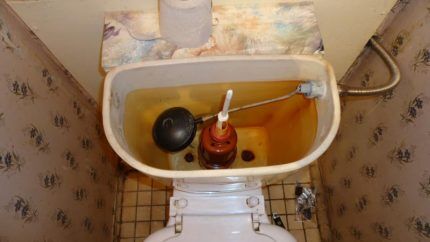
Reason #2. The accumulation of limescale deposits is facilitated by a faulty flush tank, which constantly flows, which is why it is so difficult to get rid of the crushed layer.When water hits plumbing fixtures, mineral particles accumulate.
Reason #3. Failure to follow simple rules of cleanliness in the toilet. For example, if they flush the toilet with insufficient water or forget to do it altogether. Hence bad smell, and a yellow coating.
Reason #4. Due to the use of metal brushes for cleaning, small cracks and roughness appear on the protective enamel that covers almost all toilets. It is on them that the plaque settles, gradually absorbing into the material of the product. Over time, it becomes impossible to wash such plumbing white.
Reason #5. Old Soviet toilets have a porous structure and are not covered with enamel, so quite a lot of limescale can accumulate on them.
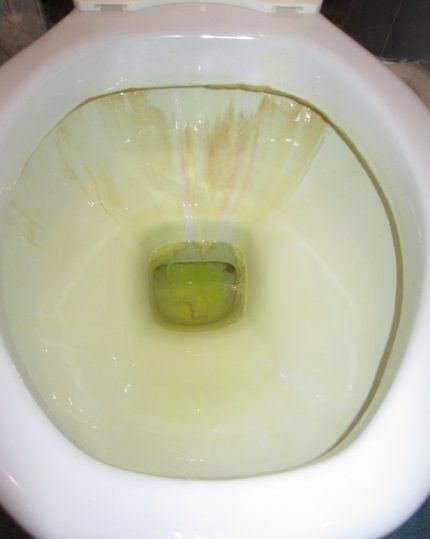
Hot water can also damage the protective layer if it is systematically poured into the toilet. After purchase and toilet installation, be sure to read the recommendations on how to care for it.
These are the main reasons why plaque may appear. And how to dissolve lime deposits on the walls of the toilet will be discussed further.
Ways to clean the toilet
For cleaning, you can use improvised means. Before using any of them you must: clean the drain, get rid of water in contaminated areas. To remove stagnant water, use a plunger or a regular plastic cup. And then apply the cleaning product.
Method No. 1 - traditional cleaning products
If the plaque has just appeared or you don’t want to use chemicals for some reason, then magical folk mixtures will come to the rescue.
Lemon acid. Apply a mixture of 2-3 sachets and water to the plaque and leave overnight. Leave the lid closed. Calculate the required amount of acid depending on the degree of contamination. In the morning, rub with a damp cloth or brush and rinse with plenty of water. If the contamination does not come off, the procedure can be repeated.

Technical oxalic acid. It was also used by our grandmothers and great-grandmothers. Apply a little powder (1-2 spoons) onto a damp soft cloth or directly onto the dirt and rub. Repeat, scrub again with a brush, but not a metal one, and rinse.
Vinegar (9%). If you find it, then acetic acid is 70%. Be sure to use a protective bandage at all stages of preparation and use of this product. Heat 250 g of vinegar to 40-45˚C.
To enhance the effect, add 2-3 teaspoons of baking soda. Then, pour the resulting mixture into the toilet and cover with the lid. Leave it like this for at least 5-6 hours, preferably all night. After this, treat with a brush and a rag, rinse with water.
Baking soda. It significantly increases the effectiveness of other remedies - vinegar, citric acid. To effectively remove plaque, take the entire pack (200 g) at once. Prepare a mixture with water, apply to plumbing fixtures and leave overnight. You can add a few tablespoons of vinegar to the mixture. After this, rub and rinse.

Electrolyte for cars. The liquid must be used very carefully, as it contains sulfuric acid. First, put on gloves, a mask and goggles, as even a drop of this product can cause a burn. Apply the substance only to a dry surface, at arm's length.
Close the lid immediately. After 15-20 minutes, but no more than several times in a row, rinse without opening the lid. Remember that Electrolyte cannot be used if plastic pipes are connected to the toilet, as the acid can damage them.
Since this product is very toxic, it should be used only as a last resort when others cannot cope with the contamination.
Hydrochloric acid. It can be found in plumbing departments or hardware stores. This acid should be used in the same way as an electrolyte. Don't forget about safety precautions.
Coca Cola. This drink, originally from the nineties, is known to everyone. To get rid of plaque, you should pour 1.5-2 liters of cola into the toilet sink and leave it overnight. Then you need to rub the dirt with a rag and rinse with plenty of water.
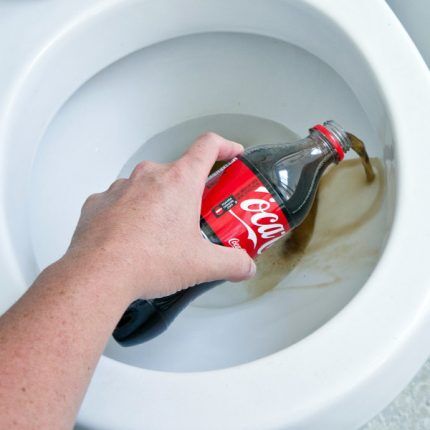
White. Wipe down the inside walls of the toilet and fill it with white. Leave it overnight, then scrub the plaque with a brush and rinse.
Iodine monochloride. This liquid can be purchased at any veterinary pharmacy. The product should be poured onto a dry surface and washed off after a few minutes.Do not leave the product on the surface for longer than 10 minutes, and also cannot be used on cast iron or aluminum pipes.
If not a single folk remedy has solved the problem, then it’s time to use household chemicals.
Method No. 2 - household chemicals
There are many toilet cleaning chemicals on store shelves today. But before using any household chemicals, you must carefully study the instructions.
According to their composition, all chemical toilet cleaning products are divided into: acidic, alkaline and chlorine-based. There are also powder products, but they are less popular.
Acidic gels and liquids are considered one of the best in the fight against settled lime, although they contain a small amount of acids. They should be used with special precautions, protecting hands and face. In addition, never overexpose the acid to avoid damaging the enamel.
One of the most popular acid gels is toilet duck. It is recommended to use it several times in a row. It is advisable to apply the gel on a dry surface.
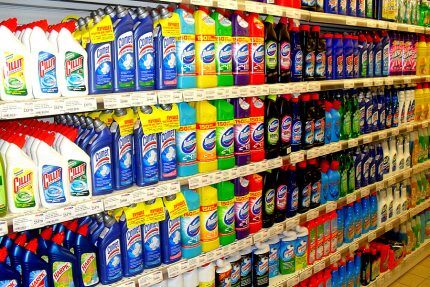
Alkaline products less dangerous than acidic ones. They can be used frequently, even daily. They are based on sodium, which dissolves plaque in a matter of minutes. For example, gels Bref, Santry, Dosya or Domestos.
Any of these products can be used regularly, but it is important to remember that they can only deal with a thin layer of limescale in one cleaning.
Chlorine-based products. After using them, the room should be ventilated.These cleanings can be done daily, but it is important to take precautions. Some of the most popular chlorine-based compounds are Titanium or Comet.
The latter is available in both gel and powder form. It has a pungent odor, so it is advisable to work with it wearing a mask.
Powdered abrasives. For example, Flash, Big Power. This chemistry will do a great job of removing stains from any age. But they should be used infrequently, since cleaning also requires the use of brushes, which can damage the enamel.
And the powders themselves literally “rip off” everything unnecessary from the surface of the toilet, so they can also damage the integrity of the enamel.
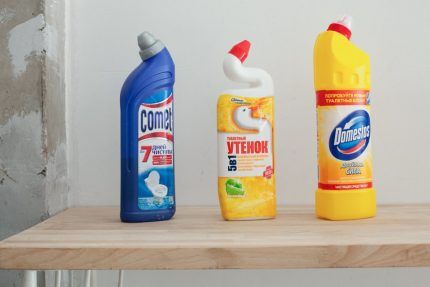
Rules for working with household chemicals
In pursuit of a clean toilet, it is important not to rush and avoid mistakes.
To do this you need to follow a few simple rules.
- To avoid causing damage to the enamel and the accumulation of new plaque, never overexpose gels and acid-based liquids.
- After cleaning, rinse off any aggressive cleaning agent with water only with the lid closed so that splashes do not get on the skin.
- To avoid chemical skin burns, vapor poisoning or an allergic reaction, try to work with household chemicals wearing protective gloves and a mask, and do not lean too much over the surface being treated.
- Never use Electrolyte or any other sulfuric acid-based liquid if metal-plastic pipes lead to the toilet.
When the cleaning is done and the toilet is sparkling clean, the question arises: how to prolong this condition and prevent the formation of new contaminants?

How to keep the toilet clean?
No matter how well you clean the toilet, after a while a new layer of plaque will form there. Therefore, it is necessary to carry out prevention as often as possible. We offer several simple preventive measures.
№1. Clean the bowl from any dirt every time and do not skimp on water for draining.
№2. Place a special product under the toilet rim that masks the odor and kills germs and plaque.

№3. Eliminate leak in the drain tank, since because of it the plaque only gets layered. If the leak is left, then after cleaning a new coating will appear very quickly.
№4. If hard water flows through the pipes, then it makes sense to throw special tablets into the toilet cistern to reduce hardness.
№5. Try not to clean the toilet with a steel brush. It leaves small cracks that destroy the enamel and contribute to the accumulation of plaque.

№6. It is advisable to clean the toilet using special products at least once a week or two, depending on how many people use it.Use only liquid or gel cleaners and soft cloths.
№7. Do not pour grease and other leftover food into the toilet, especially hot food.
By following these simple rules, you can easily keep your toilet clean. The main thing is not to let the problem get worse and carry out scheduled cleanings on time.
Conclusions and useful video on the topic
For clarity, we suggest watching several video tips.
The author shows an effective way to clean the walls of a toilet from limescale in several stages using improvised means:
Useful tips for those who want to clean the toilet seat from old stains. Vinegar is used as the main ingredient, and the author also gives useful tips:
It is quite easy to get rid of mineral deposits on the walls of the toilet. Use one of our tips, and then your toilet will sparkle with cleanliness. But remember that prevention is always cheaper than emergency cleaning.
Share with readers your secrets of keeping your plumbing clean. Please leave comments, ask questions about the topic of the article and participate in discussions - the feedback form is located below.




After moving to a new apartment, I got a toilet with plaque. As always, I turned to good old baking soda. I made a fizzy paste from baking soda and 9% vinegar and used almost the entire pack. But! Before applying this slurry, I treated the toilet with Faberlic toilet cleaner, applied baking soda without rinsing it off and left it for 6-7 hours. Afterwards I rubbed it a little with the hard side of the sponge, and the plaque was gone. Now, in order to avoid such unpleasant deposits in the future, I wash the water drain tank twice a week to prevent dirt and other troubles from accumulating.
We have very hard water, and to prevent stains from being eaten away, we have to thoroughly clean the toilet every 2-3 days. And since the toilet in the rented apartment was an old Soviet one, it was already in a sad state. I like how the toilet duck cleans, but even it can’t remove old limescale stains. We have to turn to the help of acid, which we pour in at night; my husband usually does this; he doesn’t trust me.
We bought a house from elderly people, all the plumbing there was in a sad state. For a long time we suffered with this raid. Santry was able to save the bathtub, but the toilet was not. Baking soda had virtually no effect. They filled it with Bref overnight and cleaned it thoroughly in the morning. The streaks still remained, but became less noticeable. Perhaps someone knows a proven option, just to be sure?
Try Harpic cleaner, it has never let me down. Even in fairly advanced cases it was possible, although sometimes not the first time. Well, if you have already tried several cleaning products and have not achieved results, then try the method with battery electrolyte, which is described above in the material. It is very radical, but if after it the plaque remains, then the only thing left to do is throw away the plumbing. Just be extremely careful - be sure to use a respirator, safety glasses and thick rubber gloves. The electrolyte releases sulfuric acid vapors, which is very harmful.